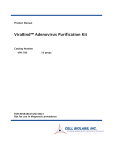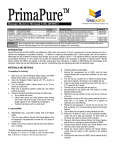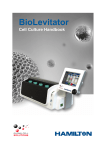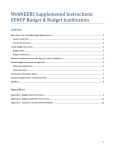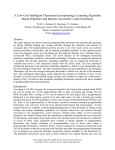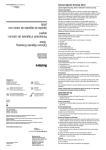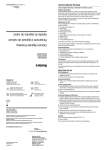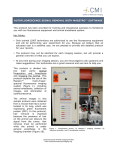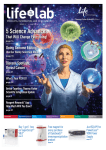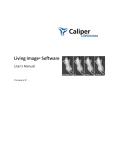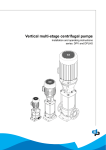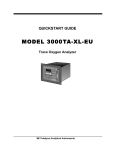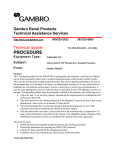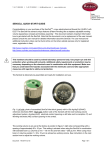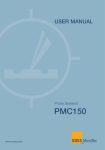Download Culturing Cells on GEM™ using the BioLevitator™
Transcript
Other Specialty Cell Products from Global Cell Solutions Culturing Cells on GEM™ using the BioLevitator ™ • 3D Stem SFM • 3D CryoShield AOF • 3-DMEM • MEM-3D • RPMI 1640-3D • 3-DMEM/F12 For more information on these products and other services from GCS, please visit our website: www.globalcellsolutions.com Global Cell Solutions, Inc. Hamilton Company, USA 770 Harris Street, Ste 104 Charlottesville, VA 22903 USA P.O. Box 10030 , Reno, NV 89520, USA +1 (800) 648-5950 or +1 (775) 858-3000 +1 (434) 975-4271 Hamilton Bonaduz AG www.globalcellsolutions.com Via Crusch 8, CH-7402 Bonaduz, GR, Switzerland +41 (81) 660 60 60 www.hamiltoncompany.com 3-D Cell Culture Simplified.™ Table of Contents Table of Contents 1. INTRODUCTION 1.1 The GEM™ ....................................................................................2 1.2 GEM™ Cultures ............................................................................4 1.2.1 Inoculation ..........................................................................4 1.2.2 Expansion ............................................................................6 1.2.3 Collection ............................................................................7 2. MATERIALS 2.1 Required Materials ........................................................................8 2.2 Supply Reordering Information ......................................................9 3. WORKING WITH THE GEM™ 3.1 Preparing the GEM™ ..................................................................10 3.2 Harvesting the Cells ....................................................................12 3.3 Inoculation ..................................................................................14 3.3.1 Preparing for Inoculation....................................................14 3.3.2 Starting the BioLevitator™ ................................................16 3.4 Maintaining BioLevitator™ Cultures ............................................17 3.4.1 Notes on Maintaining BioLevitator™ Cultures ..................17 3.4.2 Feeding the BioLevitator™ Cultures ..................................18 3.4.3 Imaging and Counting BioLevitator™ Cultures ..................20 3.5 Harvesting BioLevitator™ Cultures..............................................22 3.6 Freezing Cells on GEM™ ............................................................24 3.7 Thawing Cells on GEM™..............................................................25 4. VISUAL GUIDES 4.1 Visual Guide to Inoculation..........................................................26 4.2 Troubleshooting Visual Guide ......................................................27 4.2.1 Troubleshooting the Culture................................................27 4.2.2 Troubleshooting Cell Behavior ............................................28 5. TERMS AND CONDITIONS ................................................................29 6. REFERENCES........................................................................................30 7. NOTES............................................................................................31-32 8. CONTACT INFORMATION ..................................................Back Cover © 2009 Global Cell Solutions, Inc., All rights reserved. CULTURING CELLS ON GEM™ USING THE BIOLEVITATOR™ V1.05.09 1 1. Introduction 1. Introduction 1.1 The GEM™ The GEM™ (Global Eukaryotic Microcarrier) is a pipette-able, magnetic, alginate, microcarrier that supports the culture of adhesion-dependent cell lines. Composed of an alginate core embedded with magnetic particles and coated with covalently bound gelatin, the GEM™ is also an ideal matrix for threedimensional (3-D) biology. Complimenting the GEM™ is a digital bench-top incubator and bioreactor, the BioLevitator™. Figure 1. A 70µm confocal Z-projection of CHO cells stained with DAPI (blue), WGA (green), and Phalloidin (red). Figure 2. The GEM™ consists of an alginate core with magnetic particles and a protein coat. Protein Coat Alginate Commonly used for dental impressions and as a food additive, alginate was first used for cell culture applications as an encapsulate for storage (Pilwat G, 1980) or to immuno-isolate cells for transplantation (Lim F, 1980). Alginate is an unbranched polysaccharide collected primarily from seaweed composed of repeating guluronic (G) and mannuronic (M) acid residues. In the presence of a divalent cation, such as calcium, alginate gels. The GEM™ is composed of a dense alginate hydrogel that allows for the exchange of ions and small molecules much like the polysaccharide components of the extra cellular matrix. The alginate GEM™ core is also optically clear and non-autofluorescent. Absorbance, luminescence and fluorescence assays are easily performed with cells still attached. Simply pipette from the culture vessel into assay or immunolabel the cells for confocal microscopy as in Figure 1. Working with cells on the GEM™ ensures the proper 3-D context is maintained and avoids the use of trypsin. 2 GLOBAL CELL SOLUTIONS A thin covalently bound coat of gelatin surrounds the alginate core of the GEM™ and promotes cell adhesion. This gelatin coat can also be modified with the addition of reconstituted basement membrane or laminin. When coated with gelatin or purified proteins, the GEM™ is a unique 3-D culture substrate possessing both the protein and polysaccharide components of extracellular matrix. Magnetics Dispersed in the alginate gel are small sub-micron magnetic particles that serve to simplify culture manipulations and allow for automated culture. Media changes or assay washes using the GEM™ simplifies handling, saves time and reduces errors. The high density of the GEM™ culture also allows for a single media change to maintain up to 100 million cells. Digital spatial control using magnets is possible within automated culture systems. The BioLevitator™ possesses four independent magnets capable of holding the GEM™ stationary during automated processes occurring in the robotic CellHOST™. CULTURING CELLS ON GEM™ USING THE BIOLEVITATOR™ 3 1. Introduction 1. Introduction 1.2 GEM™ Cultures GEM™ culture, as with all cultures, consists of three phases: inoculation, expansion and collection. The same principles dictating traditional 2-D culture also apply to GEM™ culture. This section outlines the critical success factors for GEM™ culture and provides a guide for translating current culture methods into successful GEM™ cultures. Figure 3. Growth kinetics change with increased inoculation count. 1.2.1 Inoculation A successful inoculation will produce an even distribution of adhered cells across the entire GEM™ population ensuring all the surface area available is utilized for expansion. Creating a successful inoculation begins by understanding plating efficiency. Plating efficiency is best correlated to the split ratio of 2-D flask culture. Cells able to be inoculated at low numbers to large surface areas posses a high plating density and high split ratio (i.e. the population of a single flask can be split into many flasks at passage). Immortalized cells types such as HEK293 or HeLa cells often posses high plating efficiencies in contrast to primary cells types such as HUVEC that require more cells per unit area. Plating efficiency will directly impact the three critical variables for loading the GEM™ in the BioLevitator™: 1) cell-toGEM™ ratio, 2) media type and volume and 3) agitation during loading. 4 GLOBAL CELL SOLUTIONS Cell-to-GEM™ Ratio A direct correlate of the plating efficiency, the cell-to-GEM™ ratio represents the minimum number of cells required to successfully inoculate a given volume of GEM™. The simplest method for determining the cellto-GEM™ ratio is a quick titration experiment. In short, a serial dilution of cell number is administered to a fixed number of GEM™ aliquoted in a multi-well plate. Once the cell-to-GEM™ ratio is determined then any ratio higher may be used to initiate a culture. The benefit of this is illustrated in Fig. 3, on page 4, with increasing numbers of cells being added to a fixed number of GEM™. Note that the cultures will return the same number of cells, but the growth kinetics change. This may influence how you plan your experiments and the time line from inoculation to end point. Media Volume and Type Adding too much media is the most common cause of culture failure when working with the GEM™. Plating efficiency also dictates a minimum cell concentration per volume. Inoculate in small volumes of 10mL in the BioLevitator™ and slowly increase this volume as the culture expands. Depending on the growth rate of the cells the first media addition can range from within 24 hours to days. Media formulation and supplements can lower the required cells per volume and increase the percent of cells that load. The use of higher serum concentrations, richer media, and conditioned media can increase cell viability during inoculation and the adhesiveness of the GEM™. Ensure the media is not expired and supplement with additional Lglutamine as it quickly decomposes. Also consider the use of richer media such as DMEM/F12. Agitation During Loading Agitation will ensure a homogenous inoculation and prevent clumping. The BioLevitator™ provides a precise digital control of the agitation period, interval, and intensity. Agitation period is the total time committed to the inoculation phase and ranges from less than an hour to days. Observing the rate at which cells adhere to the GEM™ and therefore the agitation period can be done in a multi-well plate. Ideally this occurs concurrent to testing the cell-to-GEM™ ratio. Most cell types will load in under 4 hours. Decreasing agitation interval and increasing intensity will prevent clumping during inoculation. Use the “Visual Guide to Inoculation” in this manual to diagnose clumping and adjust your settings CULTURING CELLS ON GEM™ USING THE BIOLEVITATOR™ 5 1. Introduction 1. Introduction appropriately. 1.2.2 Expansion 1.2.3 Collection Expanding the culture is easily accomplished following a successful inoculation. As with traditional culture, the media and its components must be maintained to ensure steady growth and good yields. Use an indicator such as phenol red to monitor culture pH and richer media such as DMEM/F12 to support rapid growth. Concurrently, stirring speed may be increased to maintain the GEM™ in suspension and reduce clumping. A successful expansion requires incremental additions of media, regular media changes, and monitoring for clumping. Maintaining the cultures is discussed in further detail in section 3.4. Because the alginate core uses calcium ions to gel, in the presence of trypsin/EDTA the GEM™ dissolves. Left behind are the cells in suspension and a small number of magnetic particles which are easily removed with the CubeMagnet™. The high density of the GEM™ culture is deceiving and successful dissolution will require more trypsin than one may first estimate. For example, 50 million CHO cells on GEM™ will require a minimum of 10mL of trypsin solution to account for the large number of cells and the GEM™’s gelatin coating. 3-Dissolution™ is a trypsin alternative that can be used in excess and generally provides superior cell viability after collection. Keeping the cells on the GEM™ is the ideal method however for most applications including immunohistochemistry, cell-based assays, cryopreservation and patch clamp recording to list a few. The optically clear and non-autofluorescent GEM™ keeps cells adhered to a 3-D matrix allowing for assays to be run directly from culture. Simply dispense the pipette-able GEM™ into an assay plate and begin. Viral transduction, electroporation and chemical transfection are also all simply performed with large cell populations using the GEM™. Increasing Media Volume Expanding from the inoculation volume must be done incrementally. The ideal schedule for media addition is determined by observation and experience. Keep in mind the culture will posses a higher osmolarity than the media being added. Large additions of media can put the cells into osmotic shock which retards growth, causes cells to fall from the GEM™, and may destroy the culture. In general once the inoculation media with phenol red has become yellow, then a volume of no more than 50% of the current volume may be added. Please see the cell specific technical sheets for media addition schedules. Changing Media Media changes will increase in frequency as the cell number rises. A good estimate is that 10 million cells will consume approximately 10mL of media in 24 hours. This number can change however depending on cell and media type. Monitor the pH with phenol red and exchange no more than 50% of the media volume at one time. With optimization larger exchanges can be made. Also keep in mind that growth may posses a limiting reagent in the media that when properly supplemented can extend media lifespan. Finally, monitor cell numbers beginning 48 hours after inoculation for growth rate to optimize media changes. Observation Monitoring the culture is simply done by taking a small aliquot for observation using a microscope. The majority of GEM™ should posses cells and any clumps contain only 3 or 4 GEM™ at most. Hoechst stain is suggested because the optical clarity of the GEM™ can make it difficult to distinguish some cell types. Methods for Hoechst staining and taking cell counts are available in this manual. 6 GLOBAL CELL SOLUTIONS CULTURING CELLS ON GEM™ USING THE BIOLEVITATOR™ 7 2. Materials 2. Materials 2.2 Supply Reordering Information 2.1 Required Materials The following is a list of the supplies needed to begin cell culture in the BioLevitator™. Product Description Catalog Number 3D Cell Culture Kit 16 BioLevitator™ tubes + 4 x 2mL GEM™ (50%) GKT-3000 (1 month supply) Serological pipets CubeMagnet™ 1 Small cube shaped magnet GMM-1002 45mL BioLevitator™ Tubes BioMagnet™ 1 PTFE-coated magnet GMM-1001 3-Dissolution™ Trypsin-alternative cell dissociation reagent GSP-0100 500mL bottle GSP-0302 Equipment Reagents Consumables BioLevitator™ GEM™ substrate Pipettor tips CubeMagnet™ Culture media BioMagnet™ 3-Dissolution™ Hemocytometer (or cell dissociation reagent of your choice) (or cell counting system) Cryogenic vials Light microscope Phosphate Buffered Saline (Ca2+and Mg2+-free) (appropriate magnification for viewing cells; 10-20X objective; DAPI filter) Trypan Blue (if you are using a hemocytometer) GEM™ Global Eukaryotic Microcarriers, 4x2mL GEM™-3034 OQ Kit (Operational Quality Kit) 2mL GEM™ + 2x 2mL of 3D-validated cell line + 500mL DMEM/F12 + 4 BioLevitator™ tubes GKT-2000 Cells of your choice 48 tubes for the BioLevitator™ GTB-1000 Pipettor 37ºC, 5% CO2 incubator Multi-well plate Ice Fetal Bovine Serum (FBS) BioLevitator™ Tubes A CO2 source for the BioLevitator™ Figure 4. CubeMagnet™ 3-DPBS Ca2+and Mg2+ -free Figure 5. BioMagnet™ Figure 6. BioLevitator™Tube WARNING: CubeMagnet™ and BioMagnet™ contain a STRONG MAGNETIC DEVICE! The magnet should be stored in a safe place and handled with care to avoid injury or damage. Avoid bringing the CubeMagnet™ and BioMagnet™ within close proximity of each other. Keep at least 18 inches away from recording devices, computers, and metal objects. 8 GLOBAL CELL SOLUTIONS CULTURING CELLS ON GEM™ USING THE BIOLEVITATOR™ 9 3. Working with the Gem™ 3. Working with the Gem™ 3.1 Preparing the GEM™ Materials Needed Method: 1 vial of GEM™ substrate: 2mL of 50% packed slurry Culture Media: Use complete media that the cells are normally grown or passaged in. Warm the media to at least room temperature. CubeMagnet™ Pipettor and Tips 1. While holding one vial (2mL) of GEM™ substrate over the CubeMagnet™ to immobilize the GEM™, carefully aspirate off the storage buffer. Fig. 8. 2. Add 1mL of the media. Fig.7. 3. Cap the vial and invert to mix. 4. Repeat steps 1-3 for a total of 4 washes. These wash steps are necessary to allow the GEM™ substrate to absorb the media components and to remove the storage buffer. Omitting these wash steps may lead to sub-optimal loading of cells on the GEM™ substrate. Aspirate / wash 5. Aspirate off the final wash and add 1mL of the media. The GEM™ have been washed and acclimated in the medium. 1mL complete medium Figure 8. Hold the vial over the CubeMagnet™ 4X Magnet Figure 7: Wash and acclimate the GEM™. 10 GLOBAL CELL SOLUTIONS CULTURING CELLS ON GEM™ USING THE BIOLEVITATOR™ 11 3. Working with the Gem™ 3. Working with the Gem™ 3.2 Harvesting the Cells Materials Needed: T75 flask of cells1 : Use a flask that has reached 80-90% confluency. 3-Dissolution™2 (GCS catalog # GSP-0100) Phosphate Buffered Saline (PBS): Ca2+/Mg2+ -free Culture Media: Use complete media that the cells are normally grown or passaged in. Warm the media to at least room temperature. Hemocytometer or counting system: You may need Trypan Blue if using a hemocytometer. 10 million cells Conditioned media Pipettor and tips Serological pipets Figure 9: Harvest cells from a flask and save the conditioned media.. Light microscope: Make sure you have the appropriate magnification objective for viewing cells (a minimum of 10X objective). Method: 1. Remove and SAVE the culture medium in a 15mL or larger sterile conical tube. NOTE: This is conditioned media and contains essential growth factors that stimulate growth and adhesion. 2. Rinse the cells gently with 5.0mL of Ca2+/Mg2+ free PBS then remove. Add 5mL of 3-Dissolution™ to the flask and place in 37°C incubator. Observe and monitor the cells every 1-2 minutes until the cell layer is dispersed (time varies with cell type). 3. Add 5mL of the pre-warmed media to stop the reaction and suspend the cells by gently pipetting up and down. 4. Transfer the cell suspension to a sterile 15mL tube using a serological pipette. 1 As with other cell culture protocols, perform all manipulations of cells and cells on GEM™ described here in a biosafety hood. 2 The following protocol describes the harvesting of cells using 3-Dissolution™, a trypsin-free cell dissociation reagent (catalog # GSP-0100-101) that can be purchased from Global Cell Solutions. However, if you are using a Trypsin/EDTA-like product of your choice follow the manufacturers’ recommended protocol. This protocol assumes that the user is harvesting cells from a plastic tissue culture-treated T75 flask that is 80-90% confluent. Adjust the volumes of 3-Dissolution™ or other dissociation solution proportionately for different size flasks harvested. 12 GLOBAL CELL SOLUTIONS 5. Observe the cells with microscope to ensure a single cell suspension. 6. Determine the number of harvested cells/mL utilizing standard Trypan Blue exclusion and a hemocytometer or other counting method. NOTE: Do not agitate cells by hitting or shaking the flask. This action may cause certain cell types to clump together. A mono-dispersed culture assists in obtaining ideal loading onto the GEM™ substrate. CULTURING CELLS ON GEM™ USING THE BIOLEVITATOR™ 13 3. Working with the Gem™ 3. Working with the Gem™ 3.3 Inoculation Aspirate / wash Materials Needed: 5mL complete medium Conditioned media: This is the media you saved in the previous ‘Harvesting protocol.’ Culture Media: Use complete media that the cells are normally grown or passaged in. Warm the media to at least room temperature. 1 BioLevitator™ Tube: Label the tube with the date, the cell line, and any other experimental information. Magnet Prepare the GEM™ Pipettor and Tips 2-6 million cells Serological Pipets Conditioned media 1 vial of GEM™: Make sure the GEM™ have been washed as described previously in the protocol for ‘Preparing the GEM™’. GEM™ Single Cell Suspension: This is the 15mL tube of cells you collected in the previous ‘Harvesting’ protocol. 2x 15mL conical tubes BioLevitator™: Make sure it is properly set up and connected to a CO2 source. See the BioLevitator™ manual provided with the instrument by Hamilton Company. BioLevitator™ 3.31 Preparing for Inoculation Method: Figure 10: Combine the washed GEM and the prepared cells to start the inoculation. 1. Turn the BioLevitator™ on and pre-warm it. Adjust the carbon dioxide on the BioLevitator™ to the appropriate levels and verify that the levels are accurate (see BioLevitator™ User Manual provided by Hamilton). 2. Add 5mL of the conditioned media to the tube. 3. Add 5mL of fresh complete culture media to the tube. 4. Invert the vial of washed GEM™ as needed to re-suspend the GEM™ substrate. Quickly draw up 0.5mL of re-suspended GEM™ slurry in a pipette and dispense this into the BioLevitator tube. 5. Add an appropriate volume of cell suspension containing approximately 2 to 6 million cells to the tube1. Minimize the volume of cell suspension added. Swirl slightly to mix cells and GEM™ substrate. Seeding density will vary according to the type of cells being used and downstream application. Note: Order of addition is important! Always add cells last! 6. Put the cap on the tube and place in the BioLevitator™. 1 This is the range that is most commonly used. The example given in this manual describes maintaining a 6 million CHO cell inoculation and culture. Feel free to adjust this inoculation cell count. Contact Global Cell Solutions customer service for any questions or guidance for different inoculation counts and cell types. 14 GLOBAL CELL SOLUTIONS CULTURING CELLS ON GEM™ USING THE BIOLEVITATOR™ 15 3. Working with the Gem™ 3. Working with the Gem™ 3.3 Inoculation (continued) 3.4 Maintaining the BioLevitator™ Cultures 3.4.1 Notes on Maintaining the Cultures: BioLevitator™ Figure 11: Put the cells and GEM™ in the BioLevitator™ and begin the inoculation protocol. 3.3.2 Starting the BioLevitator™ In order to have successful growth of cell cultures, it’s important to monitor the pH of the culture environment. Most cell lines grow well at pH 7.4; however some specific cell lines may vary slightly between pH 7.0 and pH 7.7. Phenol red is commonly used a pH indicator in most culture medias. It is red at pH 7.4, orange at pH 7.0, and becomes yellow at pH 6.5, lemon yellow below pH 6.5, pink at pH 7.6 and purple at pH 7.8. The assessment of color is highly subjective, so it may be useful to make up a set of media standards. The general guide to maintaining successful cultures is to visually monitor the culture and make sure it remains in the correct pH range. When the media is ‘spent’ or seems more yellow, then it is time to replenish the culture with fresh media. However, it’s important that the cells are able to retain some of the secreted growth factors and signaling molecules that are in the ‘spent’ media. For this reason it’s important not to shock the cells or drown them by adding too much fresh media or removing too much old media at once. Never add more than 50% of the culture volume at any given time. The maximum amount of culture in one tube is 40mL, so it is fine to gradually add in media as needed until this volume is reached, and then begin to switch out old media with fresh after that point. As the cell numbers increase, so does the rate at which the media components are consumed. Fresh media may need to be added at a higher frequency. The following formula is useful in deciding when to change media: 10 million cells will use 10mL of media in a 24 hour period in normal growth. Method: 1. On the BioLevitator™ touch screen, select the tube that you are setting up for culture. (See the BioLevitator™ User Manual provided by Hamilton Company.) 2. Select the ‘Experiment’ you would like to run. If needed, adjust the inoculation, culture, or harvest parameters as described in the BioLevitator™ User Manual provided by Hamilton Company. 3. Select whether you want to run any or all of the Inoculation, Culture, or Harvest protocols for your tube (usually the Inoculation and Culture protocols are selected). Total Number of Cells in Tube/ (10 x 106) X 10 = Amount of Fresh Media to Add to Culture (ml) When the cell density becomes so high, that very frequent media changes are needed, it is then possible to split the culture into multiple tubes, or some cells may be removed, saved, or set aside to serve any desired purpose. 4. Select Start. Loading times may vary from 2 to 36 hours depending on type of cell being used, the passage number, whether the cells are fresh or newly thawed, and whether they’ve been over-trypsinized or not. 16 GLOBAL CELL SOLUTIONS CULTURING CELLS ON GEM™ USING THE BIOLEVITATOR™ 17 3. Working with the Gem™ 3. Working with the Gem™ 3.4.2 Feeding the BioLevitator Cultures Materials Needed Culture Media: Use complete media that the cells are normally grown or passaged in and make sure it contains 15mM HEPES. Warm the media to at least room temperature. Serological Pipets Following is a sample protocol for maintaining a culture of CHO K1 cells (Chinese Hamster Ovary) in the BioLevitator™. The methods are to be used as a general guideline, and in no way represent how every cell culture should be maintained. For more information on a particular cell type, or for any additional guidance, please visit the Global Cell Solutions website or contact our Technical Support1. Example of Methods for Maintaining CHO K1 BioLevitator™ Culture: Note: The first day of inoculation is referred to as Day 0. The CHO K1 culture protocol described starts at a speed of 60 RPM on day 0, increases to 68 RPM on Day 1, and to 76 RPM on Day 3. Follow the instructions in the BioLevitator™ User Manual provided by Hamilton Company to ensure that your protocol is set to these parameters, or to adjust your protocol as such. Figure 12. 20X fluorescent overlaid image stack of CHO K1 cells growing on GEM™ substrate stained with 0.1mg/ml Hoechst Stain Figure 13. A typical growth curve generated from CHO K1 cells in a BioLevitator™. 1. Day 1 of culture: Visually monitor culture. Add 5mL of fresh media to the tube. 2. Day 2 of culture: Visually monitor culture. Add 10mL of fresh media to the tube. 3. Day 3 of culture: Visually monitor culture. Take a sample for cell count starting on this day. Adjust your media accordingly. Typically, remove 5mL of ‘spent’ media and add 20mL of fresh media to the tube. 4. Day 4 of culture: Visually monitor culture. Take samples for cell counts as often as needed, and in order to accurately adjust media feedings. Use the guidelines described, and replenish media as necessary. Typically you will need to do 2 feedings on this day, about 8 hours apart, replacing 20mL of ‘spent’ media with 20mL of fresh during both feedings. 5. Day 5 and onwards: Increase the frequency of feedings to maintain optimal growth. You may need to split the cultures. Always use cell counts and the pH indicator to maintain your culture. ______________________________ 1 www.globalcellsolutions.com 18 GLOBAL CELL SOLUTIONS CULTURING CELLS ON GEM™ USING THE BIOLEVITATOR™ 19 3. Working with the Gem™ 3. Working with the Gem™ 3.4.3 Imaging and Counting BioLevitator™ Cultures Materials Needed Imaging Method: 450µL of culture: This sample should be taken from the BioLevitator™ culture tube. 50uL will be used for imaging the cells and 400uL will be used for counting. 1. Put 50µL of the cell culture sample (cells on GEM™) in one of the wells in the 96-well plate. 96-well culture plate: Make sure this is optically clear. 2. Add 100µL of the Hoechst 33342 solution to the sample in the well. 1:2000 Hoechst 33342 solution: Dilute 0.5µL of Hoechst 33342 (10mg/mL in water) in 1mL room temperature culture media. 3. Incubate the well at room temperature for 15-20 minutes. Light microscope: Brightfield with UV channel and DAPI filter; 10X objective. 4. Capture images of the sample under UV light and DAPI filter using the microscope. CubeMagnet™ Pipettor and tips Phosphate Buffered Saline (PBS): Ca2+/Mg2+ -free. Make sure this is at room temperature. 3-Dissolution™ : warm this to 37ºC (GCS catalog # GSP-0100-101) Culture media: Warm the media to at least room temperature. Hemocytometer: Make sure it’s cleaned and dried after every use. Hemocytometer coverglass: Cleaned and dried after every use. Microcentrifuge tube Cell Counting Method: 5. Use the CubeMagnet™ to draw down the remaining 400µL sample of cells on the GEM™. 6. Use the pipettor to aspirate off the media above the GEM™ culture sample. 7. Add 1mL of PBS to the culture sample. 8. Use the CubeMagnet™ again to draw down the cells on GEM™ and aspirate the PBS off this time. 9. Add 200µL 3-Dissolution™ to the sample. (More 3-Dissolution™ may be required if the cells are more confluent.) Trypan Blue: 0.4% w/v in PBS. 10. Incubate the culture sample and 3-Dissolution™ for 10-15 minutes at 37ºC. Ensure that the GEM are dissolved by observing under a microscope. 11. Neutralize the sample by adding 400µL of culture media. Use more media to neutralize if you used more 3-Dissolution™. 12. Place the coverslip evenly on the middle of the hemocytometer. 13. Add 50µL of Trypan Blue and 50µL of the cell culture sample to a microcentrifuge tube. Tap the tube to mix. 14. Remove 10µL from the cell/Trypan Blue mix with a pipettor and add 10µL to each side of the coverslip by allowing a drop held at the end of the tip to be taken under the slide by capillary action. 15. Using the hemocytometer to count the viable and non viable cells. 20 GLOBAL CELL SOLUTIONS CULTURING CELLS ON GEM™ USING THE BIOLEVITATOR™ 21 3. Working with the Gem™ 3. Working with the Gem™ 3.5 Harvesting BioLevitator™ Cultures Materials Needed: 3-Dissolution™ (GCS catalog #GSP-0100-101) Make sure the 3-Dissolution™ is prewarmed to 37°C. Phosphate Buffered Saline (PBS): Ca2+/Mg2+ -free. Make sure this is at room temperature. Culture Media: Use complete media that the cells are normally grown or passaged in. Warm the media to at least room temperature. Tube from BioLevitator™ with cells: This is the tube containing cells on GEM™ that have reached the end of the culture phase. Aspirate Count Aliquot Hemocytometer or counting system: You may need Trypan Blue if using a hemocytometer. Pipettor and tips Serological pipets Light microscope: Make sure you have the appropriate magnification of objectives for viewing cells, at least a 10X objective. CubeMagnet™ Method: 1. Remove the tube from the BioLevitator™ and place in a tissue culture hood. 2. Using the CubeMagnet™, pull the confluent GEM™ substrate to the bottom of the tube. Aspirate and discard the media without disturbing the pellet. 3. Gently wash the GEM™ substrate in 20mL of Ca2+/Mg2+ -free PBS. Using the CubeMagnet™, pull the confluent GEM™ substrate to the bottom of the tube. Aspirate and discard the PBS wash. 4. Add 10mL 3-Dissolution™.1 Gently mix solution up and down with a pipette. Continue gentle titration until GEM™ substrate dissolves. Incubation with mixing at 37ºC will help speed up the dissolution of the GEM™. You may return the tube to the BioLevitator™ and use the Harvest protocol for this step. Note: Visually monitor progress with a light microscope to make sure the GEM™ have dissolved. Additional 3-Dissolution™ may be necessary to dissolve the GEM™ entirely, especially if they are very confluent. Note: This process may take 15-20 minutes, depending upon how tightly the cells are packed on the GEM™. 20mL Ca+2/Mg+2 free PBS 5. Add 10mL of culture media to the tube to inactivate the 3-Dissolution™.2 Gently mix. 37°C Gentle Agitation 6. Using the CubeMagnet™, pull the remnants of the GEM™ substrate (little black particles) to the bottom of the tube and transfer the cell solution to a new 50mL tube. Aspirate & PBS wash 3-Dissolution™ 7. Take an aliquot of the cell suspension and obtain a cell count. Cells are ready for downstream assays or other applications. Transfer cell suspension Magnet Assay Magnetic Particles Magnet Downstream applications Figure 14: Harvest the BioLevitator culture from the GEM. 22 GLOBAL CELL SOLUTIONS 1 Keep in mind that 0.5ml of GEM™ substrate is equivalent in surface area to a T75 flask (75cm2). Increase/decrease the amount of dissociation solution accordingly depending upon the starting volume of GEM™ used in your culture. 2 If you are using a Trypsin/EDTA-like solution, add an equal volume of media. CULTURING CELLS ON GEM™ USING THE BIOLEVITATOR™ 23 3. Working with the Gem™ 3. Working with the Gem™ 3.6 Freezing Cells on GEM™ 3.7 Thawing Frozen Cells on GEM™ Materials Needed: DMSO1: Dimethyl Sulfoxide Culture Media: This can be antibiotic free and does not need to be at room temperature. Fetal Bovine Serum (FBS) Cryogenic Vials: You will need 4x 2mL pre-labeled vials.. BioMagnet™ Serological pipettes Ice: It’s easier to follow this protocol if you have the ice sitting in a flat container or bucket for easy placement of tubes and vials. It is recommended that most steps of this protocol be executed over ice. Cells: These are the cells on GEM™ from the BioLevitator™ culture. Note: DMSO will cause the cells to detach from the GEM™ substrate when it’s at room temperature. Keep all cells on GEM™, freezing media, and wash solutions ICE cold. Method: 1. Prepare 10mL of ‘DMSO Freezing Media Wash’ (5% DMSO, 20% FBS): a. Combine 0.5mL DMSO, 2mL of FBS, and 7.5mL of culture media. b. Place on ice. 2. Prepare 5mL ‘Freezing Media Wash’ (20% FBS): a. Combine 1mL of FBS and 4mL of culture media. b. Place on ice. 3. Remove the tube of cells from the BioLevitator™ and place in a tissue culture hood. 4. Using the BioMagnet™, pull the confluent GEM™ to the bottom of the tube. Aspirate all media, taking care not to disturb the GEM™ layer. 5. Gently add in 3.6mL of the ‘DMSO Freezing Media Wash’. Mix gently. 6. Using the BioMagnet™, pull the confluent GEM™ to the bottom of the tube. Aspirate the ‘DMSO Freezing Media Wash’, taking care not to disturb the GEM™ layer. 7. Repeat step 6. Aspirate the second freezing media wash, taking care not to disturb the GEM™ layer. 8. Gently add 3.6mL of ‘Freezing Media Wash’. 9. With a 1mL pipette, draw up 400ul DMSO. Add 1 drop of DMSO into the tube and swirl. Then add in 2 drops and swirl. Add in 4 drops and swirl. Continue in this fashion (doubling the number of drops used) until all 400 µl of DMSO are used. (The final concentration of DMSO in the tube will be 10%.) Materials: 20% FBS Culture Media: Make 1mL cell culture media that contains 20% FBS and has been warmed to no more than room temperature. Frozen Cells on GEM™: This is one of the cryogenic vials previously frozen containing cells on GEM™. 1 BioLevitator™ Tube CubeMagnet™ Serological pipettes BioLevitator™: Make sure the BioLevitator™ is pre-warmed and CO2 adjusted. Method: 1. Add 10mL of the 20% FBS culture media to the BioLevitator tube. 2. Thaw a cryovial of frozen cells on GEM™ in a 37°C water bath until cells are just thawed. 3. Place the cryovial on the CubeMagnet™ and pull the cells on GEM™ to the bottom of the vial. 4. Gently aspirate off the freezing media. Re-suspend the cells on GEM™ in 1mL of the room temperature culture media that contains 20% FBS and transfer to the BioLevitator tube. 5. Place the tube in the pre warmed BioLevitator™. 6. Change media as needed1. 10. Gently swirl the tube and aliquot 1mL of the cell-media-DMSO mixture into pre-labeled 2mL cryogenic vials. 11. Freeze according to ATCC Technical Bulletin No. 3, Cryogenic Preservation of Animal Cells.2 ___________________________________________________________________________________________ 1 The DMSO we have been successful using was purchased from Sigma-Aldrich (Catalog No. D2650). 2 http://www.atcc.org/common/technicalInfo/TechLit.cfm (viewed on December 3, 2005) ___________________________________________________________________________________________ 1 For further expansion of thawed cells on GEM, additional GEM may need to be added. For more information contact Customer Support. 24 CULTURING CELLS ON GEM™ USING THE BIOLEVITATOR™ GLOBAL CELL SOLUTIONS 25 4. Visual Guides 4. Visual Guides 4.1 Visual Guide to Inoculation 4.2 Troubleshooting Visual Guide Cells attach to the GEM™ in four phases. Visually monitor cell attachment onto the GEM™ at the end of the inoculation, prior to the culture phase, and identify the various stages of attachment. 4.2.1 Troubleshooting the Culture Absorption Observation: Moderate Clumping The cell is rounded and has made contact with the GEM™ and is touching it. Observation: Doublets and triplets of GEM™ are formed with cells growing in between. Explanation: Attachment These small groups are not detrimental to the culture but avoid collections of 5 or more GEM™ to ensure the total available surface area for expansion is being utilized. Observation: Solution: The cell has flattened on the side of contact with the GEM™, and appears like a rounded column attached to the GEM™ at the base of the column. Increase agitation by decreasing the agitation interval. If clumping persists, increase the agitation intensity also. Spreading Heavy Clumping Observation: The cell continues to flatten onto the GEM™ and is more "bell shaped" with a wider base. Observation: Large groups of GEM™ or the entire population are forming large masses in the BioLevitator™ tube. Fibroblasts for example are very adhesive and will seek adhesion on multiple surfaces. Solution: Settling Observation: The cell has completely flattened down on the GEM™ and has started normal cellular processes. 26 GLOBAL CELL SOLUTIONS Increase agitation by decreasing the agitation interval. If clumping persists, increase the agitation intensity also. Inoculate under constant agitation. Reduce the serum concentration. CULTURING CELLS ON GEM™ USING THE BIOLEVITATOR™ 27 4. Visual Guides 5. Terms and Conditions Section Heading 4.2.2 Troubleshooting Cell Behavior Sheeting Bridging Terms and Conditions Shedding Quality All Global Cell Solutions products are manufactured and tested to meet rigorous quality standards. Every lot of GEM™ substrate is cell culture tested. Please refer to Certificate of Analysis for further information. Product Use Observation: Observation: Observation: Confluent GEM™ present as well as GEM™ with large bare spots and loosely attached sheets of cells Cells are attached and stretched between two or more GEM™. Confluent GEM present in culture as well as viable loose cells. Explanation: Explanation: Some cell types are more prone to this behavior (ex. Fibroblasts) and link GEM™ together to increase the size of their settled footprint. Other cell types attach to multiple GEM™ because of insufficient agitation/mixing. Some cell types exhibit this behavior when they reach confluency on the GEM™. GEM™ cultures continue to divide (unlike the halting of growth due to contact inhibition in a 2D flask) and one of the daughter cells remains attached to the GEM™ while the other becomes free floating. Explanation: Osmotic shock to cells can be caused when too much media is added or exchanged at one time, and this can cause sheeting. Solution: Do not add or exchange more than 50% of the total volume in media. For example, a 10mL culture should receive a maximum of 10mL of fresh media while a 40mL culture should receive a maximum of 20mL of media exchange. 28 Solution: Increase the agitation speed, especially during the inoculation phase, to reduce the frequency of attached cells coming in contact with another GEM™ OR reduce the agitation pause during the inoculation phase. Solution: Add additional GEM™ substrate to the culture at the first sign of shedding so the culture can continue to expand. You may also harvest the shed cells for downstream applications while maintaining the BioLevitator™ culture as a miniature cell factory. GLOBAL CELL SOLUTIONS You may use the Materials1 solely for internal research purposes in your laboratory, and for no other purpose whatsoever. Without limitation, you may not attempt to reverse engineer or design around the Materials, generate analogs of or derivatives based on the Materials, expose the Materials to humans or use the Materials in humans, chemically analyze or chemically modify the structure of the Materials, develop formulations of the Materials or use the Materials for any commercial purpose. You may not sell, transfer, disclose or otherwise provide access to the Materials to any person, entity or location without the prior written consent of GCS, except that you may allow access to the Materials to individuals performing research under these Terms; provided, that such individuals are bound by written agreement to use the Materials only in the manner permitted under these Terms. Handling of Materials. You understand and agree that the Materials may have unpredictable and unknown biological and/or chemical properties, that they are to be handled and used with caution, and that they are not to be used for testing in or treatment of humans. The Purchaser will handle and use the Materials in compliance with all applicable laws and regulations. 1 Disclaimer of Warranties. The materials are supplied to you with no warranties of any kind, express or implied, including any warranty of merchantability or fitness for a particular purpose or that they are free from the rightful claim of any third party, by way of infringement or the like. GCS makes no representations that the use of the materials will not infringe any patent or proprietary rights of any third parties. Limitation of Liability. In no event will GCS be liable for any use by the purchaser of the materials or any loss, claim, damage or liability of any kind which may arise from or in connection with the use, handling or storage of the materials by or through purchaser. The purchaser hereby agrees to indemnify, defend and hold harmless GCS, its employees, independent contractors from damages, costs or expenses for any loss, claim, injury or liability of whatsoever kind or nature, including without limitation any resulting from any illness or injury to persons or property, whatever the cause may be, which may arise from the purchaser’s use, handling or storage of the materials, even if GCS has been advised of the possibility of such damages. Purchaser agrees that the foregoing limitations of liability shall apply even if a limited remedy provided hereunder fails of its essential purpose. Trademarks: GEM™, CubeMagnet™, BioMagnet™, 3-Dissolution™ (Global Cell Solutions); Sigma-Aldrich® (Sigma-Aldrich). Tangible materials to be provided to you by Global Cell Solutions. CULTURING CELLS ON GEM™ USING THE BIOLEVITATOR™ 29 6. References 7. Notes References Lim F, S. A. (1980). Microencapsulated islets as bioartificial endocrine pancreas. Science., 210(4472):908-10. Pilwat G, W. P. (1980). Immobilization of human red blood cells. Z Naturforsch, 35(3-4):352-6. 30 GLOBAL CELL SOLUTIONS CULTURING CELLS ON GEM™ USING THE BIOLEVITATOR™ 31 7. Notes 32 GLOBAL CELL SOLUTIONS Contact Contact Dear Participant, Thank you for choosing automated 3D Cell Culture. We appreciate your efforts and are ready to assist you and your organization through this process. Please use the following information to reach us with questions or comments. Corporate Global Cell Solutions, Inc. 770 Harris Street Suite 104 Charlottesville, VA 22903 +1 (434) 975-4271 (main) +1 (434) 975-4216 (fax) Scientific Attn: Automated 3D Cell Culture [email protected] www.globalcellsolutions.com




















